Adi Kailash, also known as Chhota Kailash, is a majestic peak situated in the Himalayan range within the Pithoragarh district of Uttarakhand, India. Standing at an elevation of 5,945 meters above sea level, this mountain holds profound spiritual, cultural, and geographical significance. Revered as a sacred site in Hinduism, Adi Kailash is considered a divine counterpart to Mount Kailash in Tibet and is an integral part of the revered group of peaks known as the Panch Kailash.
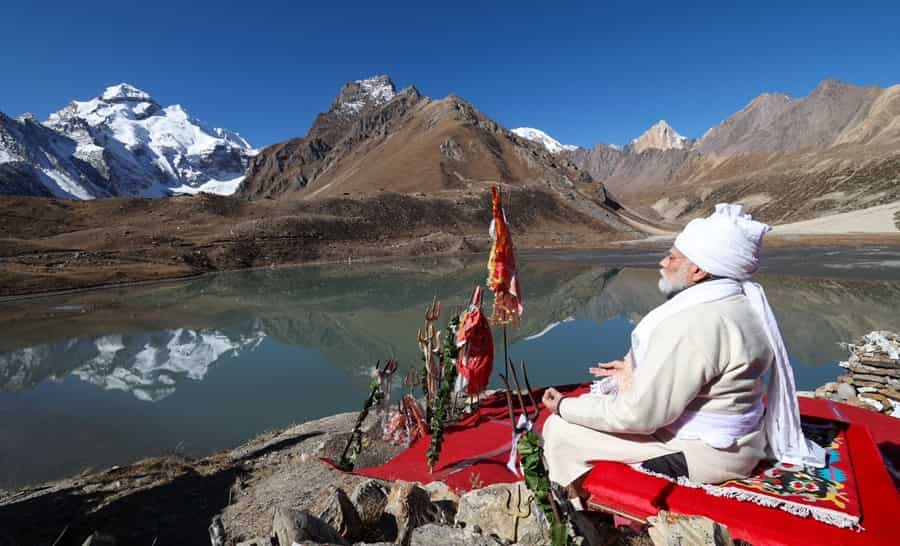
Historical and Mythological Significance
Earthly Abode of Lord Shiva
In Hindu mythology, Adi Kailash is believed to be an earthly manifestation of Lord Shiva’s divine abode. Lord Shiva, one of the principal deities in Hinduism, is said to have meditated in this sacred region for eons. Adi Kailash represents the eternal bond between Lord Shiva and Goddess Parvati, symbolizing their divine love and spiritual union.
According to various scriptures, Lord Shiva’s presence in Adi Kailash signifies his profound connection with Goddess Parvati and reflects his divine form. This association makes Adi Kailash a key pilgrimage site for devotees seeking blessings and spiritual enlightenment.
Testing of Parvati’s Devotion
One of the most compelling legends associated with Adi Kailash is the story of Lord Shiva testing Goddess Parvati’s devotion. The tale unfolds as follows:
Goddess Parvati, deeply in love with Lord Shiva, desired to marry him. However, Lord Shiva, engrossed in his spiritual practices, was reluctant to enter into marital life. To test Parvati’s commitment, Shiva set her a series of arduous tasks. Undeterred by the challenges, Parvati completed each task with unwavering dedication. Impressed by her devotion, Lord Shiva agreed to marry Parvati, symbolizing their eternal union. This legend adds a layer of deep spiritual significance to Adi Kailash, marking it as a sacred site of divine love and devotion.
Panch Kailash: The Five Sacred Peaks
Adi Kailash is part of the revered group of peaks known as the Panch Kailash, which are believed to embody various manifestations of Lord Shiva. The Panch Kailash include:
- Kailash Mansarovar: Located in Tibet, it is considered the primary abode of Lord Shiva and is the most renowned among the five.
- Adi Kailash: Also known as Chhota Kailash, this peak is situated in Uttarakhand, India, and is considered a sacred counterpart to Kailash Mansarovar.
- Shrikhand Mahadev Kailash: Situated in Himachal Pradesh, this peak holds significant spiritual importance.
- Kinnaur Kailash: Another sacred peak in Himachal Pradesh, revered for its spiritual connection.
- Manimahesh Kailash: Located in Himachal Pradesh, it is considered an important site of worship.
The Panch Kailash collectively represent Lord Shiva’s divine manifestations and are integral to Hindu spiritual practices.
- Suggested Tour: Kailash Mansarovar Yatra Packages
Cosmic Dance and Divine Form
Adi Kailash is also associated with the legend of Lord Shiva performing his cosmic dance, known as the Tandava. According to mythology, Lord Shiva performed this powerful dance to reveal his divine form to Sage Ashtavakra. The mountain’s sacred aura and its connection to the Tandava further enhance its spiritual significance, attracting devotees who seek to witness or feel the divine presence associated with this cosmic event.
Geographical Significance
Elevation and Terrain
Adi Kailash rises to a height of approximately 5,945 meters above sea level, making it a formidable peak within the Himalayan range. The challenging terrain requires significant physical stamina and preparation. The rugged landscape, combined with the high altitude, offers a unique experience for trekkers and pilgrims alike.
The geographical location of Adi Kailash near the India-Tibet border adds to its mystique. The mountain’s remote and rugged setting contributes to its spiritual allure and makes it a captivating destination for those seeking both adventure and spiritual fulfillment.
Natural Beauty and Changing Positions
One of the intriguing aspects of Adi Kailash is its perceived ability to change positions. This phenomenon has captivated the imagination of many and is considered a key attraction for pilgrims. The mountain’s natural beauty, including its snow-capped peaks and serene lakes, creates a breathtaking backdrop that enhances the spiritual experience for visitors.
Sacred Sites and Temples
Adi Kailash Temple
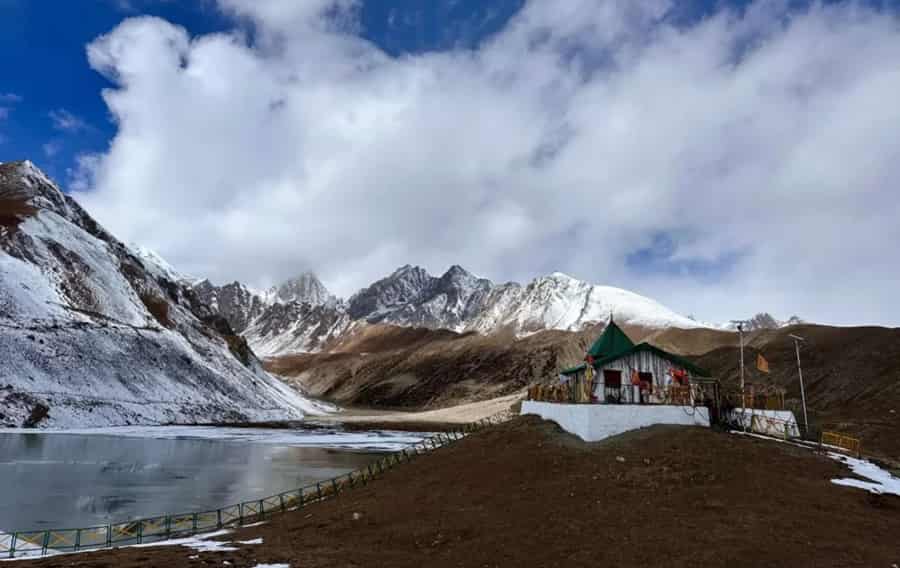
At the heart of the Adi Kailash pilgrimage is the Adi Kailash Temple, dedicated to Lord Shiva. This temple is a central site for devotees undertaking the Adi Kailash Yatra, a pilgrimage journey to the sacred mountain. The temple holds immense religious significance and serves as a place for spiritual reflection and worship.
Gauri Kund (Jolingkong Lake)
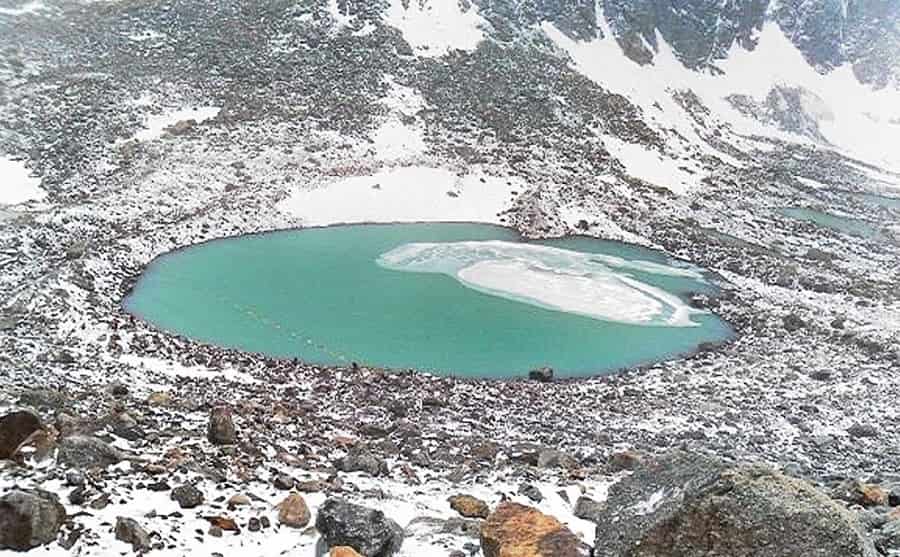
Located at the base of Adi Kailash, Gauri Kund, also known as Jolingkong Lake, is a sacred water body situated at an elevation of 5,608 meters. Named after Goddess Parvati, Gauri Kund is believed to be the site where Parvati sought refuge to regain her divine strength after battling the demon Jalandhar. The lake’s waters are considered to possess healing properties, and many devotees undertake a pilgrimage to bathe in its sacred waters, seeking purification and blessings.
The natural beauty of Gauri Kund, reflecting the grandeur of Adi Kailash, creates a serene and spiritually uplifting environment for visitors. The lake is a vital stop during the Adi Kailash Yatra, providing a space for contemplation and spiritual rejuvenation.
Om Parvat
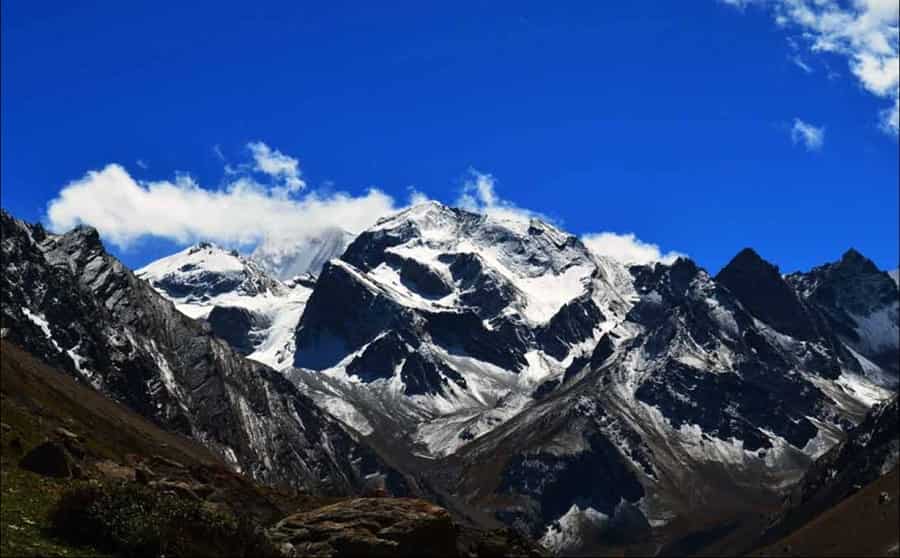
Om Parvat, located near Adi Kailash, is a sacred peak known for its unique shape that resembles the sacred Hindu symbol “Om.” Rising to an elevation of 5,590 meters, Om Parvat is considered a significant spiritual site. The mountain’s resemblance to the Om symbol is believed to represent the divine presence and is an important landmark for spiritual seekers and devotees.
Parvati Sarovar
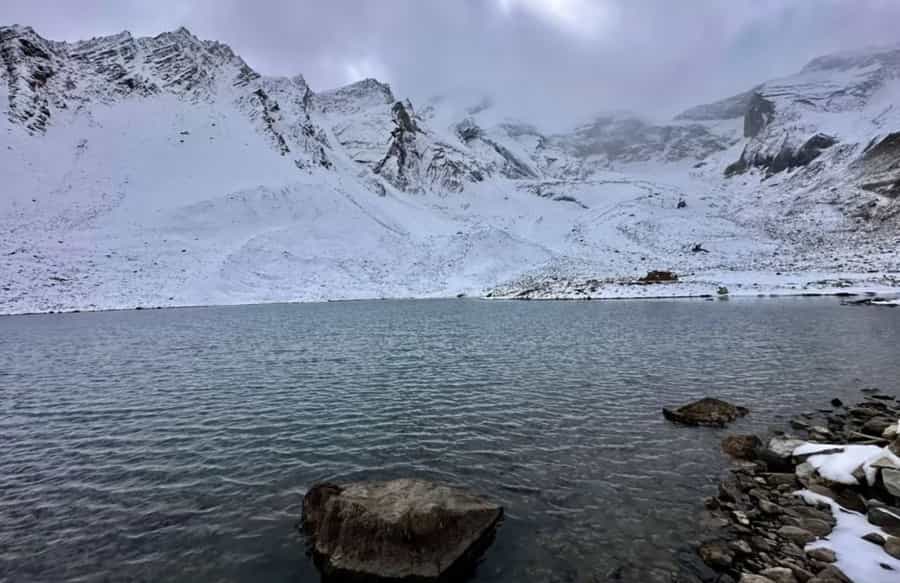
Situated 2 kilometers from the peak of Adi Kailash, Parvati Sarovar is a sacred lake at an elevation of 4,497 meters. This lake is considered a miniature version of Mansarovar Lake near Mount Kailash in Tibet, further enhancing the spiritual significance of Adi Kailash. Local legends suggest that Parvati Sarovar was blessed by Goddess Parvati herself, and its waters are believed to bestow good fortune and spiritual growth upon devotees.
The lake’s serene environment and its reflection of Adi Kailash add to its allure, making it a popular destination for pilgrims who seek to experience its divine energy and engage in spiritual practices.
Pilgrimage and Yatra
Adi Kailash Yatra
The Adi Kailash Yatra is a significant pilgrimage journey undertaken by devotees to reach the sacred mountain. The yatra typically commences in mid-May and concludes in mid-October, with the most favorable periods being from mid-May to June and September to mid-October. The pilgrimage involves traveling through challenging terrain and high altitudes, requiring physical endurance and spiritual commitment.
The Gunji-Lampiya Dhura Pass Road (GLDPR) has recently been constructed, significantly improving accessibility to Adi Kailash. This motorable road has reduced the distance and travel time to the sacred site, making the yatra more comfortable and convenient for pilgrims. The road also provides a viewpoint from which Om Parvat can be seen, enhancing the overall experience of the journey.
Major Attractions
- Adi Kailash Parikrama: The circumambulation of the sacred Adi Kailash mountain is a central highlight of the yatra. This ritualistic practice involves walking around the mountain as an act of devotion and reverence.
- Spiritual Pilgrimage: The Adi Kailash Yatra offers a profound spiritual experience for devotees, allowing them to connect with the divine and seek blessings from Lord Shiva and Goddess Parvati.
- Association with Epic Tales: The yatra is steeped in mythical stories and legends from Hindu scriptures, adding to its spiritual and cultural significance.
Attractions Along the Yatra
Pandav Fort
Located in Kuti village, the Pandav Fort is believed to be a historical site where the Pandavas from the Mahabharata stayed during their exile. The fort is named after Mata Kunti, the mother of the Pandavas, and holds historical and cultural significance.
Kunti Parvat
Kunti Parvat, situated in the last village of India, Kuti, is named after Mata Kunti. The mountain is closely associated with the Pandavas and is considered an important site for pilgrims.
Brahma Parvat
Brahma Parvat, dedicated to Lord Brahma, is visible during the journey from Kuti village to Jolingkong. The mountain’s association with the Hindu God of Creation adds to the spiritual significance of the region.
Pandav Parvat
Pandav Parvat is a group of five mountains near Adi Kailash, representing the five Pandava brothers. The peaks are considered to be dedicated to the Pandavas and are part of the broader pilgrimage experience.
Parvati Mukut
Parvati Mukut, meaning the “crown of Goddess Parvati,” is a stone formation on a mountain opposite Adi Kailash. The structure resembles a crown and is believed to be a divine marker associated with Goddess Parvati.
Shiv Parvati Temple
Located near Parvati Sarovar, the Shiv Parvati Temple is dedicated to Lord Shiva and Goddess Parvati. The temple is accessible after a trek from Jolingkong and provides a space for prayer and worship.
Gauri Kund
Gauri Kund, located at the base of Adi Kailash, is a small water body known for its chilly waters. The kund is considered sacred, and visiting it is an important part of the pilgrimage.
Conclusion
Adi Kailash stands as a symbol of spiritual significance and divine presence in the Himalayan region. Its rich tapestry of mythological tales, historical importance, and challenging terrain makes it a revered destination for pilgrims and spiritual seekers. The mountain’s sacred sites, including temples, lakes, and peaks, offer a profound connection with the divine and provide a unique journey into the heart of Hindu spirituality.
The Adi Kailash Yatra, with its enhanced accessibility and spiritual depth, continues to attract devotees from around the world, offering them a chance to experience the sacredness of this Himalayan gem. Whether through its mythological associations, its breathtaking natural beauty, or its spiritual significance, Adi Kailash remains a cherished destination for those seeking enlightenment and connection with the divine.
- Suggested Tour: Adi Kailash Helicopter Tour Package with Om Parvat

 Call
Call WhatsApp
WhatsApp Enquiry
Enquiry